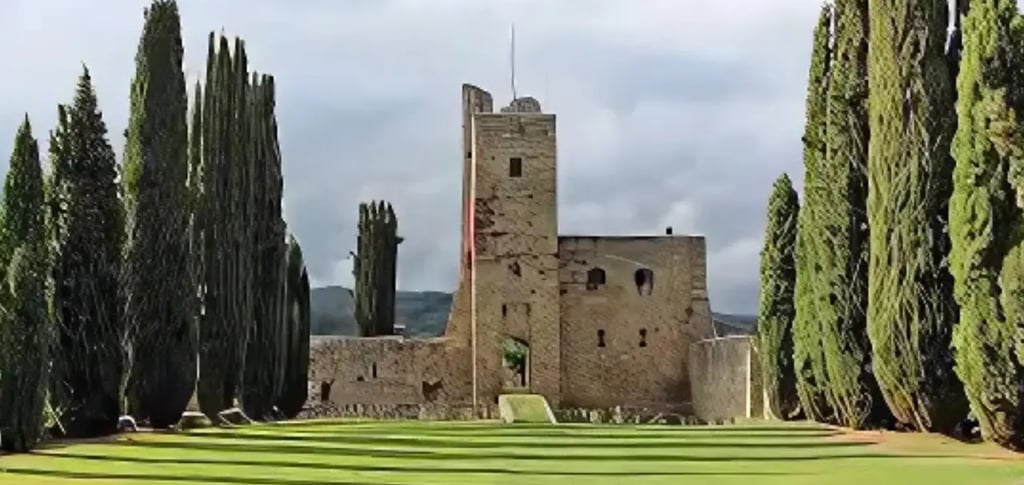Romena Castle Tuscany: Dante’s Medieval Sanctuary in Casentino Valley
Discover Romena Castle in Tuscany’s Casentino Valley, a medieval stronghold tied to Dante Alighieri and centuries of legends. Explore its hidden gems, history, and insider travel tips.
TOSCANA


Have you ever stood among ancient ruins and felt the weight of centuries press gently against your chest, as if the stones themselves were trying to tell you their stories? Romena Castle does exactly this — these weathered walls don't just stand as silent monuments, they actively whisper tales of exile, betrayal, and poetic genius that changed the course of literature forever.
This is where Dante Alighieri found refuge during his darkest days, and where some believe he penned verses that would echo through eternity.
Standing on a gentle rise in the Casentino Valley, the ruins of Romena Castle look like something torn straight from the pages of medieval poetry. Once a proud fortress of the Guidi Counts, today it holds an aura of mystery, still echoing with the footsteps of pilgrims, monks, and poets.
But above all, Romena is remembered as a place that touched the life and work of Dante Alighieri. Exiled from Florence, Dante found refuge in Casentino — and Romena Castle became one of his sanctuaries, where legends, betrayal, and inspiration merged.
The Medieval Roots of Romena
The Casentino Valley, tucked between the Apennines and the rolling heart of Tuscany, is rich with stone villages, monasteries, and castles. Romena was among the most powerful. Built around the 11th century, it became the seat of the Guidi Counts, who controlled much of eastern Tuscany.
The fortress had high towers, massive walls, and a commanding view of the valley — both a defensive stronghold and a symbol of aristocratic pride. It also sat near a vital road connecting Florence and Arezzo, making it a crossroads for merchants, armies, and exiles.
Dante's Connection to Romena
In 1301, when Dante was condemned to exile from Florence, he sought protection among the noble families of Tuscany. The Guidi lords of Romena welcomed him.
This is where Dante is believed to have worked on parts of the Divine Comedy. In Inferno, Canto XXX, he places an infamous counterfeit incident at Romena: the execution of Mastro Adamo, who was accused of producing false Florentine florins under the patronage of the Guidi.
Romena, therefore, is both sanctuary and stain in Dante's memory — a place of shelter and of human corruption. That complexity gives the castle its aura, combining italian stories of loyalty, betrayal, and poetic vision.
Walking Through the Ruins Today
The castle may be a ruin now, but the atmosphere is unforgettable. You pass through ancient gates, trace the remains of towers, and stand in the grassy courtyards where lords once held court. From the walls, the Casentino Valley spreads wide, green in spring and golden in autumn.
Just below lies the Pieve di San Pietro a Romena, a Romanesque parish church from the 12th century, still intact and hauntingly beautiful. Its capitals are carved with biblical figures and symbolic animals, whispering medieval theology in stone.
For travelers seeking off beaten path Italy, Romena delivers authenticity. No crowds, no ticket lines, just the quiet company of history and nature.
Legends and Hidden Stories
The Alchemy of Counterfeit
One of the darkest legends tied to Romena is that of Mastro Adamo, the counterfeiter burned at the stake in 1281. Dante immortalized his punishment in the Divine Comedy. Locals still speak of his ghost wandering near the castle ruins, weighed down by the golden coins that sealed his fate.
Dante's Inspiration
Some scholars argue that Dante's stay here inspired the landscapes of Purgatory — the layered mountains and forests of Casentino matching his poetic vision. Walking the winding paths, it's not hard to imagine the poet's eyes turning valleys into verses.
A Pilgrim's Stop
Romena was also a waystation for medieval pilgrims traveling along the route to La Verna, the sanctuary where St. Francis received the stigmata. This sacred geography still breathes through Casentino, blending religion and myth.
Not Everyone Knows
The castle's stones were reused in local farmhouses after its decline, meaning Romena quite literally lives on in the valley's walls and homes.
A nearby spring, called Fonte di Dante, is said to have refreshed the poet during his exile. Travelers still stop there for a sip of cold, pure water.
The Casentino is also home to some of the hidden gems in Italy, like Poppi Castle and the Camaldoli Hermitage — equally soaked in medieval atmosphere.
Locals maintain a slower rhythm, a taste of Italian lifestyle that resists mass tourism.
Romena in the Context of Tuscany's Beauty
While Florence, Siena, and Pisa are among the beautiful cities of Italy, there's a unique charm in valleys like Casentino. Romena adds depth to Tuscany's image: not just Renaissance art and Chianti wine, but rugged medieval towers and whispering forests.
It's the kind of site where you don't just take photos; you breathe the air, hear the silence, and imagine Dante's pen scratching verses by candlelight.
Travel Tips for Visiting Romena
How to Get There
The Casentino Valley is about 50 km from Florence. The best way to reach Romena is by car, driving through winding roads lined with chestnut and pine forests. Public transport exists but is limited; a car offers the freedom to explore other off-beat villages.
When to Go
Spring and autumn are ideal. Summer can be hot, but evenings at Romena are magical, with fireflies glimmering in the castle's shadow. In winter, the mist gives the ruins a ghostly, atmospheric touch.
What to Bring
Comfortable shoes — the ruins require a bit of climbing. A light jacket, even in summer, since the valley can be breezy. And always a notebook if you want to channel your inner Dante.
Pairing Romena with Other Stops
Combine your visit with the Pieve di San Pietro a Romena, the spiritual silence of Camaldoli Hermitage, and the dramatic cliffs of La Verna Sanctuary. This makes for a full-day itinerary tracing Tuscany's medieval and sacred heart.
Insider Advice
Don't rush. Bring a picnic, sit by the ruins, and let the centuries settle around you. Unlike crowded Tuscan hotspots, this is one of those hidden gems in Italy where stillness is the true attraction.
